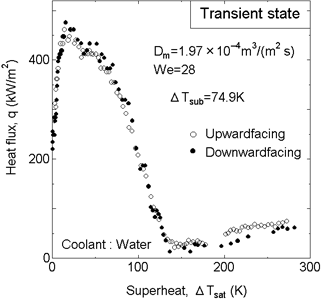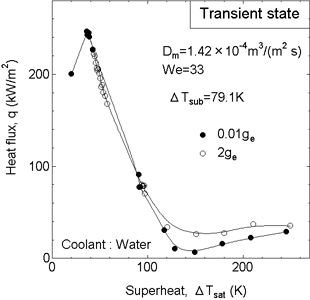1. For We higher than 80, each droplet is crashed to spread on the
heater surface, then it is split into small fragments.
2. For We lower than 80, each droplet may be once deformed to spread on
the heater surface but it soon recovers its spherical form and then rebounds
from the surface.
Since We in the experimental conditions in Fig. 7 is as low as 28,
liquid droplets inevitably rebound. In fact, the velocities of rebounding
droplets were actually measured with the LDV (Table 2). Each of those droplets
once rebound from the heater surface facing upward possibly repeated such
a rebounding motion, thereby continually contributing to the heat removal
from the heater surface. On the other hand, the droplets once rebounded
from the downward-facing surface were scattered away, causing no further
thermal interaction with the surface. Thus, the deterioration in heat transfer
in the film boiling region observed with the downward-facing surface is
reasonably ascribable to the above-mentioned difference in droplet-rebounding
behavior between the two surface orientations.

Fig. 7 Comparison of the Results of Two Terrestrial, Low Volume-Flux, Water-Spray
Experiments Using Opposite Heater-Surface Orientations
Table 2 Measured Velocities of Droplets
|
Volume fluxDm
|
We
|
Droplet velocity
|
Vm (m/s)
|
|
(m3/(m2・s))
|
|
Downward
|
Upward
|
|
1.42×10-4
|
33
|
7.4
|
-1.7
|
|
1.97×10-4
|
28
|
12.5
|
-2.3
|
|
3.70×10-3
|
622
|
17.3
|
-
|
|
|
 Fig. 8 Spray Cooling
Characteristics for Water at a Low Volume Flux Fig. 8 Spray Cooling
Characteristics for Water at a Low Volume Flux
Water (Reduced and Elevated Gravity)
1. Low Spray Volume Flux (<1.0×10-3 m3/(m2.s))
The cooling characteristics for water at a low spray volume flux, 1.42×10-4
m3/(m2.s), are presented in Fig. 8. We find no appreciable difference in
the heat transfer near the CHF point between the reduced and the elevated
gravity conditions. A significant heat-transfer deterioration under the
reduced gravity is observed in the film boiling region. The above facts
may be ascribed to a variation of droplets/heater-surface interaction with
a change in the surface superheating, which is discussed below.
In a superheating range not far from the CHF point, droplets 50-100mm
in diameter vaporize immediately after their fall onto the heater surface.
Most of these droplets neither coalesce each other nor fall into a rebounding
motion before they vaporize away. Thus, it is unlikely that any change
in gravity alters the droplets/heater-surface interaction near the CHF
point as long as the spaying condition is in the low spray volume flux
region.
In the film boiling region, droplets spayed onto the heater surface
may rebound. (Note that We = 33 in the experiments of present interest.)
Those droplets possibly keep continual interaction with the heater surface
in the presence of a gravity working toward the heater surface. Such a
continual droplets/heater-surface interaction may be lost with a reduction
in gravity. 2. High Spray Volume Flux (> 1.0×10-3 m3/(m2.s))
The spray cooling characteristics for water at a high spray volume
flux, 3.7×10-3 m3/(m2.s), are presented in Fig. 9. Here we find that the
CHF under the reduced gravity is raised above the one under the elevated
gravity by about 10 percent. This gravity dependency prevails in the transition
boiling region; it is lost in the film boiling region.
|